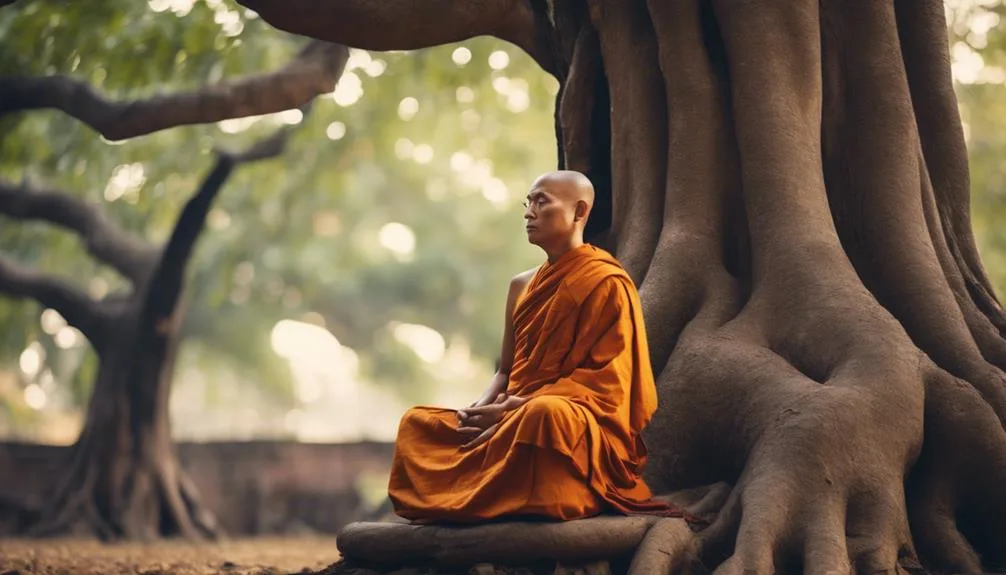The enigmatic origins of meditation, tracing back thousands of years, reveal a practice deeply intertwined with the dawn of human civilization. As we peel back the layers of history, we uncover the profound impact of meditation on various cultures, particularly within the rich tapestry of Eastern traditions.
Buddhism, with its emphasis on mindfulness and concentration, propelled the practice into a cornerstone of spiritual development, influencing countless generations. This exploration invites us to reflect on how ancient wisdom, preserved through time, continues to shape our modern pursuit of wellness and inner peace, offering intriguing perspectives on its evolution and enduring relevance in today's fast-paced world.
Key Takeaways
- Meditation dates back thousands of years, with practices observed among early hunter-gatherers and shamans.
- The concept of meditation originates from the Latin 'meditatum', meaning to ponder.
- Buddhism significantly shaped formal meditation techniques, emphasizing mindful awareness.
- Early meditation knowledge was primarily transmitted orally through generations.
Early Meditation Practices
Delving into the annals of human history reveals that the practice of meditation, with its multifaceted origins, was an integral part of early human societies across various cultures, serving both spiritual and practical purposes.
Hunter-gatherer techniques often involved forms of meditation that were deeply intertwined with their daily activities, survival strategies, and rituals. These practices were not only aimed at achieving a heightened state of awareness and connection with the natural world but also served as a means to enhance focus and mental clarity for hunting and gathering.
Similarly, shamanic traditions across different cultures employed meditation as a core aspect of their spiritual and healing practices. Through trance states and journeying, shamans accessed altered states of consciousness, using meditation as a bridge to communicate with the spiritual realm, seek guidance, or perform healing.
These early forms of meditation underscore the universal human quest for inner peace, understanding, and connection with the greater cosmos.
Meditation's Linguistic Roots
Exploring the etymological evolution of 'meditation' reveals its deep-rooted significance across various cultures. The term can be traced back to the Latin term 'meditatum,' which means to ponder. This linguistic evolution underscores the concept's broad applicability and cultural significance. It highlights its transcultural journey from a word denoting a personal, introspective practice to a global phenomenon encompassing multifaceted spiritual, religious, and secular practices.
The term's voyage through languages and epochs reflects its adaptability and enduring relevance. It illustrates how societies have continually found value in the introspective contemplation that meditation provides. This cross-cultural appreciation and adaptation of meditation underscore its universal appeal. It serves as a bridge between diverse cultural traditions, offering a common ground for inner exploration and understanding.
Buddhism and Mindfulness

Buddhism significantly contributes to the foundation and proliferation of mindfulness practices, emphasizing the cultivation of a focused, aware, and compassionate state of being. The principles of mindful living are deeply rooted in Buddhist teachings, fostering a holistic approach to mental and emotional well-being.
- Mindful living is a core tenet of Buddhism, aiming for presence and consciousness in every moment.
- Buddhist teachings advocate for mindfulness as a method to alleviate suffering and achieve enlightenment.
- The practice of mindfulness in Buddhism transcends mere meditation, incorporating ethical living and compassion towards all beings.
- Cross-cultural exchange has enriched the understanding of mindfulness, blending traditional Buddhist principles with contemporary psychological insights.
Zen Meditation Origins
Tracing the origins of Zen meditation leads us to the heart of ancient Chinese Chan Buddhism, from which this distinctive practice emerged, blending deep philosophical underpinnings with the pursuit of spiritual awakening.
As Chan Buddhism spread to Japan, it evolved into what is now known as Zen, a term that signifies meditation. This cultural transition marked by Japanese influence led to the refinement and popularization of various meditation techniques, notably zazen or seated meditation.
Zen meditation emphasizes the importance of sitting in quietude, focusing on breath, and observing the mind without attachment to thoughts. This practice aims at achieving a state of 'satori' or enlightenment, highlighting a path toward inner peace and self-realization.
The cross-cultural journey of Zen from its Chinese origins to Japanese refinement has significantly shaped its methodologies and philosophical essence, making it a unique blend of traditions and insights.
Eastern to Western Journey

How did meditation, originating from Eastern spiritual traditions, find its way into the fabric of Western culture, thereby altering perceptions and practices of mindfulness across the globe? The journey of meditation from East to West is a striking example of cultural exchange and spiritual evolution, reflecting a global thirst for ancient wisdom and inner peace.
This transition can be attributed to several key factors:
- Historical encounters between Eastern and Western explorers and scholars.
- Increased global communication fostering curiosity about alternative spiritual practices.
- The rise of scientific interest in meditation's benefits on mental and physical health.
- Cultural icons and thought leaders adopting and promoting meditation in the West.
These elements collectively facilitated a cross-cultural fusion, enriching Western spirituality and broadening the global understanding of mindfulness practices.
The 19th Century Surge
The 19th century marked a pivotal era in the Western embrace of meditation, fueled by an amalgamation of historical encounters, burgeoning global communication, and a growing fascination with Eastern spiritual practices. This period was characterized by significant colonial influence, which, paradoxically, facilitated a deeper understanding and appreciation of the cultures under colonial rule.
Improved communication technology of the era, such as the telegraph, and increased travel opportunities allowed for more direct exchanges between West and East. Scholars, intellectuals, and spiritual seekers in the West began to delve into the philosophical and spiritual texts of the East, translating and interpreting them for a Western audience. This cross-cultural exchange laid the groundwork for the integration of meditation practices into Western society, setting the stage for its expansion in the following century.
Mid-20th Century Popularity

Gaining momentum in the mid-20th century, meditation transcended its traditional Eastern roots, captivating a global audience with its promise of inner peace and self-awareness. This period marked a pivotal era of cultural integration, where western influence played a significant role in shaping the global perception of meditation.
To understand this phenomenon, consider the following aspects:
- Cultural Ambassadors: Eastern practitioners and Western enthusiasts facilitated the cross-cultural exchange of meditation practices.
- Scientific Curiosity: The West's growing interest in empirical evidence led to early research on meditation's benefits.
- Media and Literature: Publications and news outlets began featuring meditation, increasing its visibility and accessibility.
- Social Movements: The counterculture of the 1960s and 1970s embraced meditation as a tool for peace and personal transformation, further embedding it into Western consciousness.
Mindfulness-Based Stress Reduction
Developed by Dr. Jon Kabat-Zinn in the late 1970s, Mindfulness-Based Stress Reduction (MBSR) represents a pivotal advancement in the integration of meditation practices into Western therapeutic contexts.
MBSR is meticulously designed, combining mindfulness techniques with stress relief strategies to create a program that addresses the psychological, physiological, and emotional facets of stress. It transcends cultural boundaries, drawing from the ancient Buddhist practice of mindfulness, yet it is structured to meet the needs of a modern, diverse audience seeking solace in a fast-paced world.
Health Benefits Explored

Exploring the health benefits of meditation reveals a significant impact on physical and mental well-being across diverse cultures. This ancient practice, with its roots deeply embedded in history, transcends cultural boundaries to offer a universal solution for the modern world's ailments. The analytical exploration of its benefits showcases how meditation not only serves as a tool for stress relief but also plays a crucial role in cognitive enhancement.
- Stress Relief: Meditation significantly reduces cortisol levels, leading to lower stress.
- Cognitive Enhancement: Enhances memory, focus, and decision-making abilities.
- Emotional Well-being: Promotes emotional stability and reduces symptoms of anxiety and depression.
- Physical Health: Has been linked to lower blood pressure, improved immune system function, and pain reduction.
These benefits, deeply rooted in ancient practices, underscore meditation's relevance in today's fast-paced world.
Modern Meditation Techniques
In the realm of modern meditation techniques, an array of practices has emerged, reflecting a synthesis of traditional wisdom and contemporary science. These techniques not only foster mental well-being but also incorporate physiological insights, ensuring a holistic approach to self-care.
| Technique | Focus Area | Origin |
|---|---|---|
| Mindful Breathing | Breath awareness | Cross-cultural, rooted in Buddhist and yogic practices |
| Body Scan | Physical sensations | Developed within Mindfulness-Based Stress Reduction (MBSR) |
| Loving Kindness Practice | Cultivation of compassion | Buddhist Metta meditation |
Mindful breathing and visualization techniques encourage present-moment awareness, reducing stress and enhancing clarity. The body scan technique fosters a deep connection with bodily sensations, promoting relaxation. Loving kindness practice, originating from ancient traditions, nurtures a compassionate attitude towards oneself and others, demonstrating meditation's adaptability and enduring relevance.
Frequently Asked Questions
How Did Early Hunter-Gatherer Societies Conceptualize the Purpose of Meditation, and What Role Did It Play in Their Communities?
Early hunter-gatherer societies likely viewed meditation as a tool for mental clarity and spiritual connection, integral to their nomadic lifestyles and diet, fostering community cohesion and enhancing adaptability to their environment through mindful practices.
Were There Any Specific Rituals or Objects Associated With Meditation Practices in Ancient Times That Are Not Commonly Known Today?
In ancient meditation practices, the air was often perfumed with fragrant ancient perfumes, and practitioners adorned themselves in ceremonial garments, signifying a deep, cross-cultural reverence for these sacred rituals, now obscured by the sands of time.
How Did the Understanding and Practice of Meditation Diverge Among Different Ancient Civilizations Outside of the Well-Documented Eastern Traditions?
The divergence in meditation practices among ancient civilizations can be attributed to variations in cultural contexts, including ancient sports and trade routes, which facilitated cross-cultural exchanges and influenced unique meditative traditions outside of Eastern philosophies.
In the Historical Context, Were There Any Notable Figures or Leaders Outside of the Buddhist Tradition Who Advocated for Meditation Practices, and What Were Their Contributions?
In historical exploration, several notable figures beyond Buddhist tradition advocated for meditation, incorporating philosophical influences and military applications. These contributions showcased meditation's versatility across cultures, enhancing strategic thinking and personal well-being.
How Have the Materials and Spaces Designated for Meditation Evolved From Ancient Times to the Present, Reflecting Changes in Societal Values and Technological Advancements?
The evolution of meditation spaces and materials, from ancient sanctuaries to modern architecture and digital meditations, reflects shifts in societal values and technological advancements, emphasizing accessibility, personalization, and the integration of meditation into daily life.
Conclusion
In conclusion, meditation, with its venerable origins and transformative journey across cultures and epochs, serves as a testament to the enduring quest for inner peace and understanding.
Like the ancient mariners navigating vast, uncharted waters, practitioners of meditation today continue to explore the depths of human consciousness, seeking solace and enlightenment.
This age-old practice, evolving through millennia, not only bridges the gap between ancient wisdom and modern science but also offers a sanctuary for the soul in the tumultuous seas of contemporary life.

